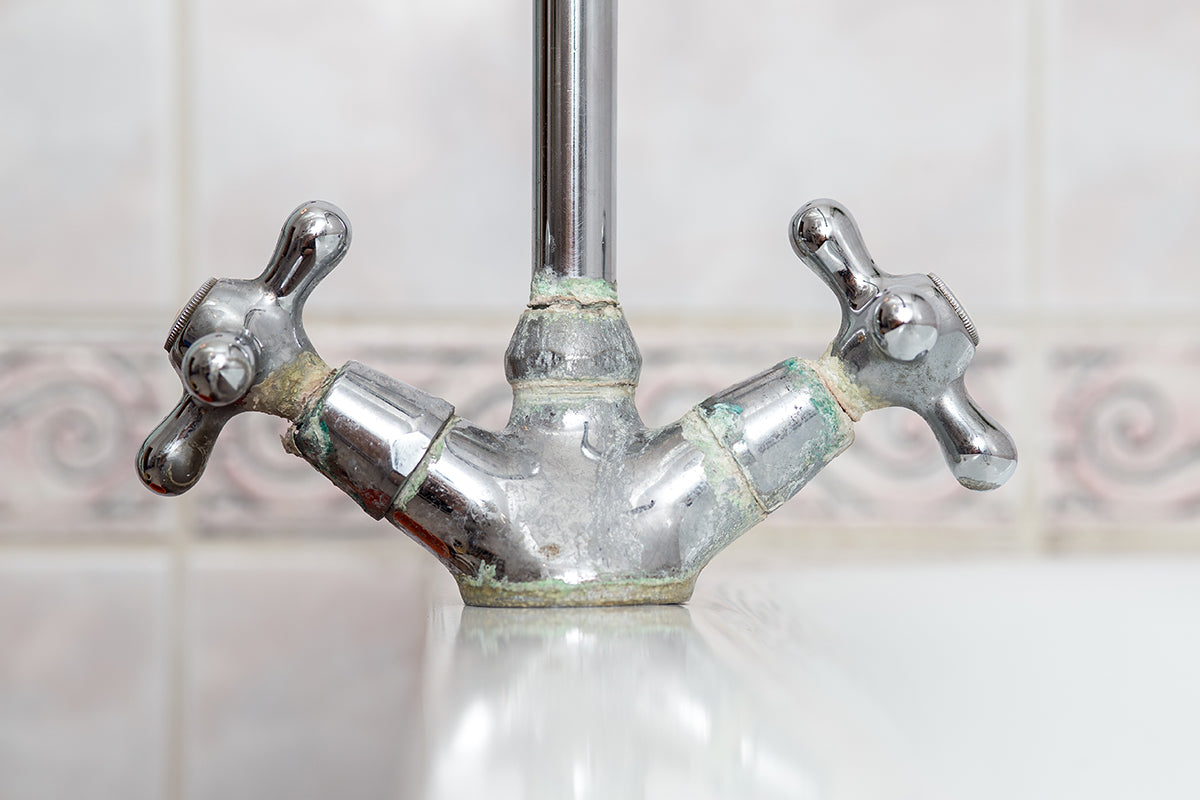
Limescale Explained: Causes, Prevention and Removal Tips
|
|
Time to read 6 min
Written by: Taps UK
|
Published on
|
Time to read 6 min
Limescale is a hard, chalky deposit made up of calcium and magnesium minerals that form when hard water evaporates. It often appears in everyday places like taps, shower heads, and kettles, leaving surfaces dull and difficult to clean. But limescale doesn’t just build up where you can see it—it can also collect inside pipes, radiators, washing machines, and dishwashers, reducing efficiency and even shortening the lifespan of your appliances. Understanding what limescale is and how it forms is the first step in learning how to prevent and remove it effectively.
Limescale is a hard, chalky deposit made mostly of calcium carbonate. It forms when hard water evaporates, leaving minerals behind on surfaces.
It clogs taps, showerheads, and appliances, reducing efficiency and water flow. Over time, it can damage fittings and increase energy bills.
Wipe taps and sinks dry after use.
Use limescale removers regularly.
Fit a water softener or filter to reduce hardness.
Clean showerheads weekly with vinegar.
Kettles, coffee machines, dishwashers, washing machines, and showers are the most common areas where limescale builds up.
Yes. Areas with hard water, such as London, the South East, and the East of England, experience heavier limescale deposits.
Limescale is a hard, chalky deposit that comes from minerals in hard water, mainly calcium and magnesium. When water evaporates or gets heated, these minerals are left behind, forming that stubborn build-up you often see around the home.
It doesn’t always look the same. On shiny surfaces like chrome taps or coloured plastics, it usually shows up as a white, crusty layer. In places like the inside of a toilet bowl, where the ceramic is also white, it tends to collect gradually, leaving unsightly stains that are harder to spot at first but very noticeable over time.
In short, if you live in a hard water area, limescale is almost impossible to avoid—but it can definitely be managed with the right cleaning and prevention methods.
One of the frustrating things about limescale is that it shows up almost everywhere water is used. Some areas are obvious, while others are hidden out of sight until problems start.
Common visible spots:
Taps and mixers – white crusty deposits around the spout or base.
Shower heads – blockages that reduce water flow and pressure.
Kettles and coffee machines – flakes floating in your drink and dull-looking elements.
Sinks and baths – chalky marks that are tough to scrub off.
Hidden trouble areas:
Toilets – stains build up inside the bowl or under the rim, often going unnoticed.
Pipes and plumbing – a gradual build-up can restrict water flow.
Boilers and radiators – reduced efficiency and higher heating bills.
Washing machines and dishwashers – scale on heating elements shortens their lifespan.
So while limescale may just look like an eyesore on your taps, it’s also quietly affecting the performance of your appliances and plumbing if left untreated.
At first, limescale might just seem like an annoying white mark on your taps, but it can cause bigger issues if left untreated.
The main problems caused by limescale:
Reduced efficiency – build-up inside boilers, kettles, or radiators makes them work harder, which means higher energy bills.
Shorter lifespan for appliances – washing machines, dishwashers, and kettles wear out quicker when heating elements are coated in scale.
Plumbing blockages – deposits inside pipes and shower heads restrict water flow, lowering water pressure.
Unsightly stains – hard, chalky marks on taps, sinks, and toilets can make even a clean bathroom look dirty.
Hygiene concerns – rough, scaly surfaces can trap dirt and bacteria, making cleaning more difficult.
So while limescale may look harmless, it’s actually costing you money, damaging your appliances, and making your bathroom harder to keep clean.
The good news is that limescale can be removed with the right approach. Whether you prefer natural solutions or stronger chemical cleaners, the method you choose depends on the surface and severity of the build-up.
Natural Cleaning Methods
White vinegar – soak taps, shower heads, or kettle elements in vinegar to dissolve scale.
Lemon juice – great for smaller areas like taps or tiles, leaving a fresh smell too.
Baking soda paste – mixed with water, this works well on stubborn stains in toilets or sinks.
These eco-friendly options are cheap, safe, and ideal for regular maintenance.
Chemical Descalers
For heavy limescale deposits or appliances like washing machines and dishwashers, commercial descaling products are often more effective. They’re designed to dissolve tough build-up quickly, but should be used with care and according to instructions.
Step-by-Step Removal Tips
Taps and shower heads – soak a cloth in vinegar and wrap it around the area, leave for an hour, then scrub gently.
Toilets – apply a descaler or vinegar solution under the rim, leave overnight, and brush away stains.
Kettles and coffee machines – fill with a vinegar or descaling solution, run a cycle, then rinse thoroughly with fresh water.
Always Check Manufacturer Guidelines
Before using any cleaning product, check the manufacturer’s care instructions for your taps, shower heads, or appliances. Some harsh cleaners can tarnish chrome, stainless steel, or specialist finishes like brushed brass or matt black. Sticking to approved cleaning methods will keep your fixtures looking new and protect your warranty.
Regular cleaning, combined with the right products for your fixtures, will stop limescale from becoming a bigger problem and extend the life of your bathroom fittings.



While cleaning removes existing deposits, the best approach is to stop limescale from forming in the first place. A few simple steps can reduce build-up and make your bathroom and appliances easier to maintain.
Long-Term Solutions
Install a water softener – reduces calcium and magnesium levels in hard water, preventing scale at the source.
Use tap or shower filters – point-of-use filters help reduce deposits on visible fixtures.
Regular Maintenance
Wipe surfaces dry – after using taps, sinks, or showers, quickly wipe down to stop standing water leaving marks.
Rinse appliances – kettles and coffee machines last longer if descaled regularly with vinegar or specialist cleaners.
Clean little and often – frequent light cleaning prevents heavy build-up, making the job easier.
Smart Product Choices
When buying new taps, showers, or appliances, look for designs that are limescale-resistant. Many modern fixtures include easy-clean nozzles or protective coatings that help reduce scale and staining.
Preventative measures not only protect your fixtures and appliances but also save you time and money on cleaning and repairs.
Having the right products makes dealing with limescale much easier. From everyday cleaners to specialist accessories, these tools can help keep your bathroom and kitchen looking their best.
Cleaning Products
Vinegar-based sprays – eco-friendly and effective for light deposits on taps, tiles, and shower screens.
Dedicated limescale removers – stronger chemical formulas designed to tackle stubborn build-up in kettles, toilets, and shower heads.
Multi-purpose bathroom cleaners – many include anti-limescale agents for day-to-day cleaning.
Descaling Treatments
Kettle and coffee machine descalers – available in liquid or tablet form, keeping appliances running efficiently.
Washing machine and dishwasher treatments – prevent limescale build-up on heating elements and internal parts.
Accessories and Prevention Aids
Tap aerators – reduce water splashing and help minimise deposits.
Magnetic descalers – attach to pipes to reduce limescale build-up in plumbing systems.
Water softeners and filters – long-term solutions that cut limescale across the whole home.
Choosing the right products ensures you can manage limescale effectively—protecting your fixtures, extending the life of your appliances, and keeping your bathroom sparkling clean.
Limescale is a stubborn deposit caused by hard water, commonly found on taps, shower heads, toilets, and inside appliances like kettles and washing machines. While it may start as an unsightly mark, limescale can reduce efficiency, increase energy bills, and shorten the lifespan of your fixtures and appliances. With the right cleaning methods, preventative measures, and care products, you can keep your home free from build-up and protect your investment in bathroom and kitchen fittings.
Limescale forms in hard water areas when calcium and magnesium minerals are left behind after heating or evaporation.
It builds up everywhere water is used, from visible spots like taps and showers to hidden areas like pipes and boilers.
Problems include reduced efficiency, higher costs, appliance damage, and unsightly stains.
Cleaning methods vary – natural remedies (vinegar, lemon, baking soda) work for light deposits, while chemical descalers tackle heavy build-up.
Prevention is key – water softeners, regular maintenance, and limescale-resistant fixtures can reduce future problems.
Taps UK is a prominent online retailer in the United Kingdom, specializing in a wide variety of kitchen and bathroom products. The company boasts a large selection of taps, sinks, and accessories from both well-known industry brands and its own exclusive lines, catering to a broad customer base that includes the general public as well as trade professionals like developers and builders.
Email Us: hello@tapsuk.com
Call Us: 01527 868500
Get all the latests news and offers from our team right to your inbox
Accepted payment methods:
© 2025 TAPS UK . All Rights Reserved.






